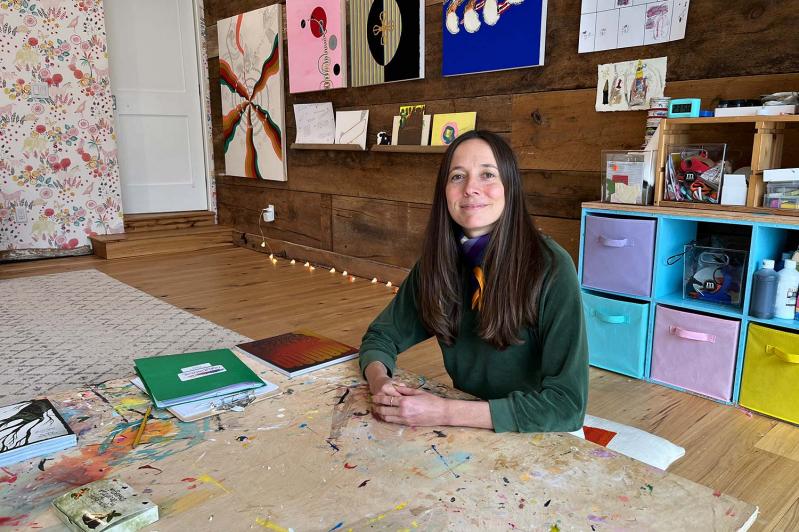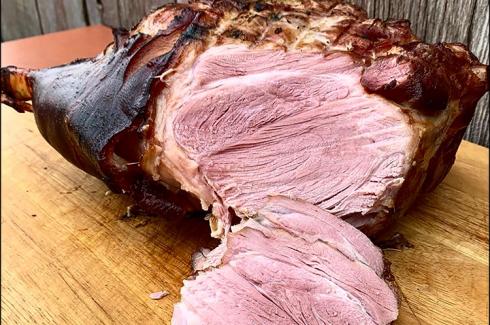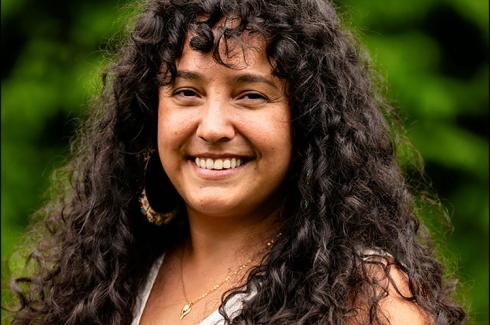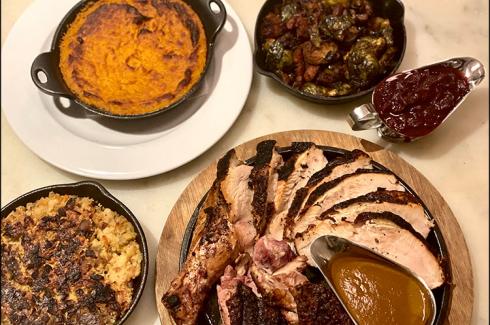Sunlight filtering through windows greets a visitor to Pia Leighton’s studio in Amagansett. Shelves of art supplies line the walls, which also feature artwork — her own alongside children’s paintings, too. A cat named Khaleesi, a curious, gentle Scottish fold, roams about freely.
This is where Ms. Leighton, the creator of a mindful art program called Whisker and Brush, comes to create and teach art.
“It’s such a joyful place for me,” she said in an interview over a hot homemade blend of chai tea. “I realized I am doing exactly that thing that I have always liked.”
Ms. Leighton came to art by way of studying literature. She moved to the United States from Chile in 2004 with a scholarship in hand for doctoral studies in literature at New York University. While studying and living in the city, she came to meet a Tibetan thangka master who would inspire her to become an artist in addition to a writer.
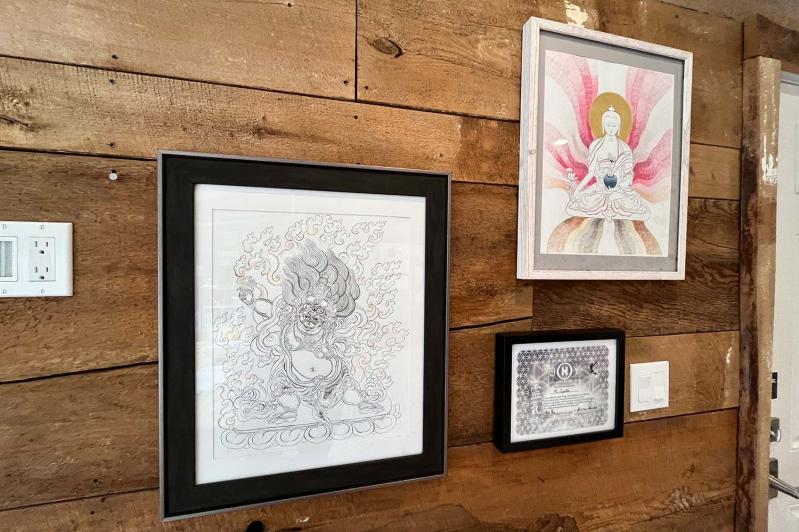
Thangka, which roughly translates to “recorded message,” is a Tibetan Buddhist art form that dates to the 11th century. “Unequivocally one of the greatest art forms of Asia,” according to Art of Tibet, an artist collective based in Nepal and Sweden, thangka is “considered Buddhist iconography. Each painting will symbolically represent divinities and passages based on the teachings of the Buddha. A great amount of skill and study is also required to paint a Thangka, as each ornament, posture, and attribute represents a particular aspect of Buddhism and its teachings.”
“That was my arts education,” Ms. Leighton said. “I asked him if he would teach me, and he said ‘yes,’
and gave me a time and an address and I showed up. I showed up for 11 years. Even living here, I took the Jitney every Monday.”
She ultimately began teaching it, too, and now offers a new session each month of a Monday morning class for adults that she calls Drawing the Buddha. Her students leave “feeling grounded, focused, and ready for the week ahead,” she said.
“It’s a meditative type of drawing, because it’s really for developing concentration. I wish I had had that as a child, but in fact, when I was writing my dissertation, I don’t think I would have finished it if I hadn’t been drawing the Buddha.”
The method begins with a grid of lines, including a central vertical line and two diagonals, that guide the artist in getting the Buddha’s proportions correct.
“When I do traditional Tibetan art, I give myself to it,” Ms. Leighton said. “This, for me, is a meditation and a grounding place. I don’t think about how well I will do this — it’s practice.”
It stands in stark contrast to her own artwork, which to a visitor appears wild and free — unbound by any tradition. “When I do my other art, what I am doing is I am energetically connecting and processing information at the same time and putting it on a canvas,” she said. “It really is like writing a poem. The way that I move a verse or replace a conjunction or a preposition, I get the same feeling when I decide to pick one color over the other or use a certain material. I think for me it’s always an energy that presents itself, and what I do is match it visually as much as I can.”
She created, for instance, a series that she calls “Deplorable Archetypes,” which are “intentionally ugly paintings,” she said. They combine animal figures — a pig-like creature with lobsters for feet or something resembling a “female, nine-tailed fox demon-spirit,” for example.
Sometimes, in her work, Ms. Leighton will make use of the paint left over from one of her Art Clubs — the name she has given to her children’s classes, which also run in monthlong sessions.
“I used to throw it away, but I started using it,” she said. “It is so cool because I have all these colors that I would never have mixed myself.”
She moved to Amagansett in 2013, when it was time for her daughter to begin prekindergarten. Her daughter is now 13 and a student at East Hampton Middle School, and her son is 8 and attends the Amagansett School.
Originally from Santiago, Chile, and the youngest of four siblings, Ms. Leighton’s first creative interest was writing. Two of her siblings, her sisters, are artists: one a ceramicist, the other a painter and architect. “That’s probably why I didn’t choose art,” she said. “I
wanted to do my own thing. What am I going to study that they aren’t?”
In her family, art and culture “were very important values,” she recalled. “I was exposed to a lot of art as much as possible. The country was still in a dictatorship for my first eight years so it’s not like I was going to art shows with my mother, but there was a consciousness for art.”
Growing up she attended a “big and traditional” school for girls, which she found difficult until she leaned in to the learning. This, she said, now informs her approach with her young students.
“Instead of focusing on things I didn’t like and how difficult it was for me to keep up because my mind was always in a creative space, I started enjoying the new opportunities,” Ms. Leighton said. “I took theater, I took history of religions — my literature teacher was really engaging. I still hated math and physics and chemistry, but that wasn’t the focus anymore. That’s an important point because when I work with the kids now, I am focusing on their joy.”
She said her youth art classes are quite different from what her students might experience in school. “There’s not just art, there’s also a moment to get grounded with meditation at the beginning. I let them share something about their day. . . . Sometimes a kid comes in heavy and leaves lightly.”
She wants her students to feel proud of their work. “Kids might come here thinking they are bad at art because someone made a comment,” she said. “Nobody’s a bad painter. They just haven’t learned to paint.”
In addition to teaching art and making her own, Ms. Leighton is working on a novel and writing a lot of poetry. (Professionally, she also practices a reiki method called Pause in Joy.) At this point in time, she said she is feeling a tremendous crossover between her art and literature.
“I feel like at the end, everything is poetry,” she said. “You’re building meaning. Whether you’re using visual materials or words, what you’re building is a new meaning — a new way to see things, and even transformation of the way that you feel.”

